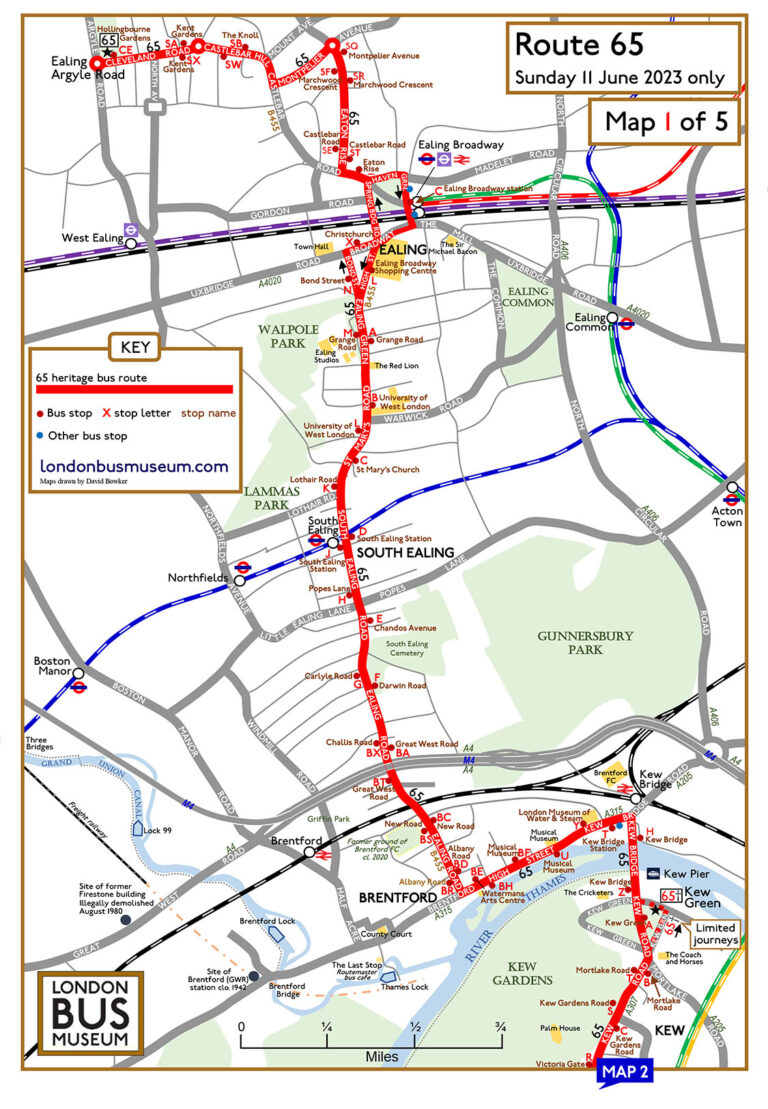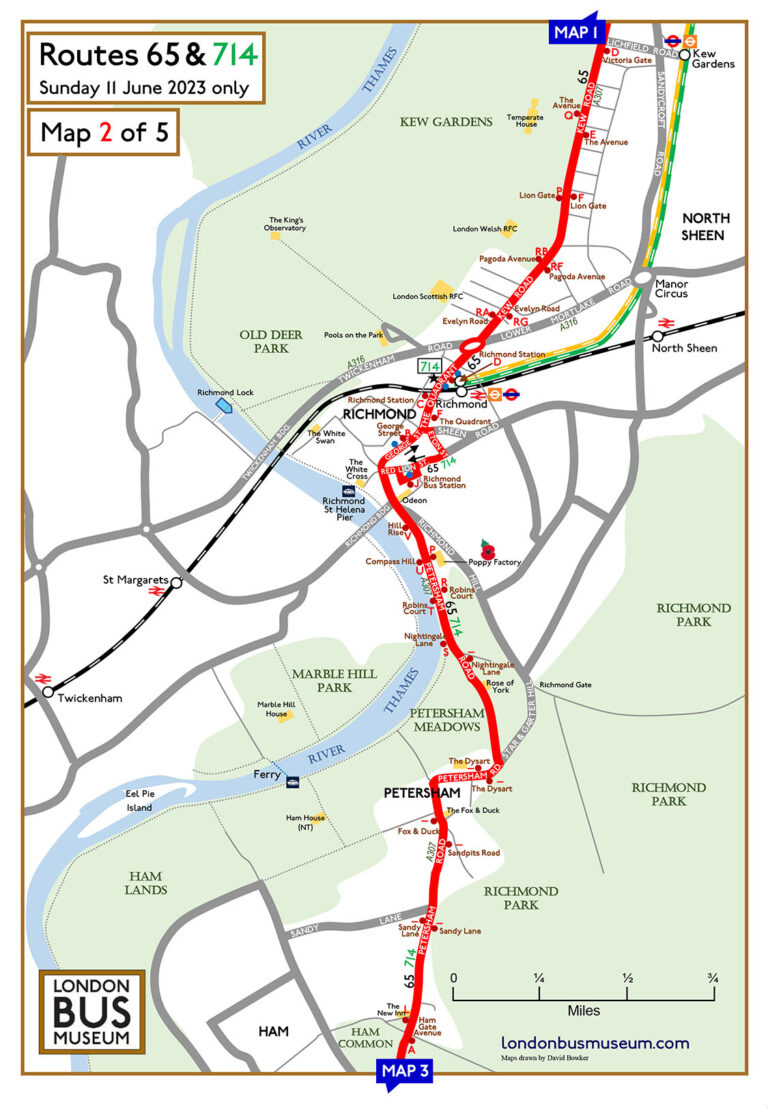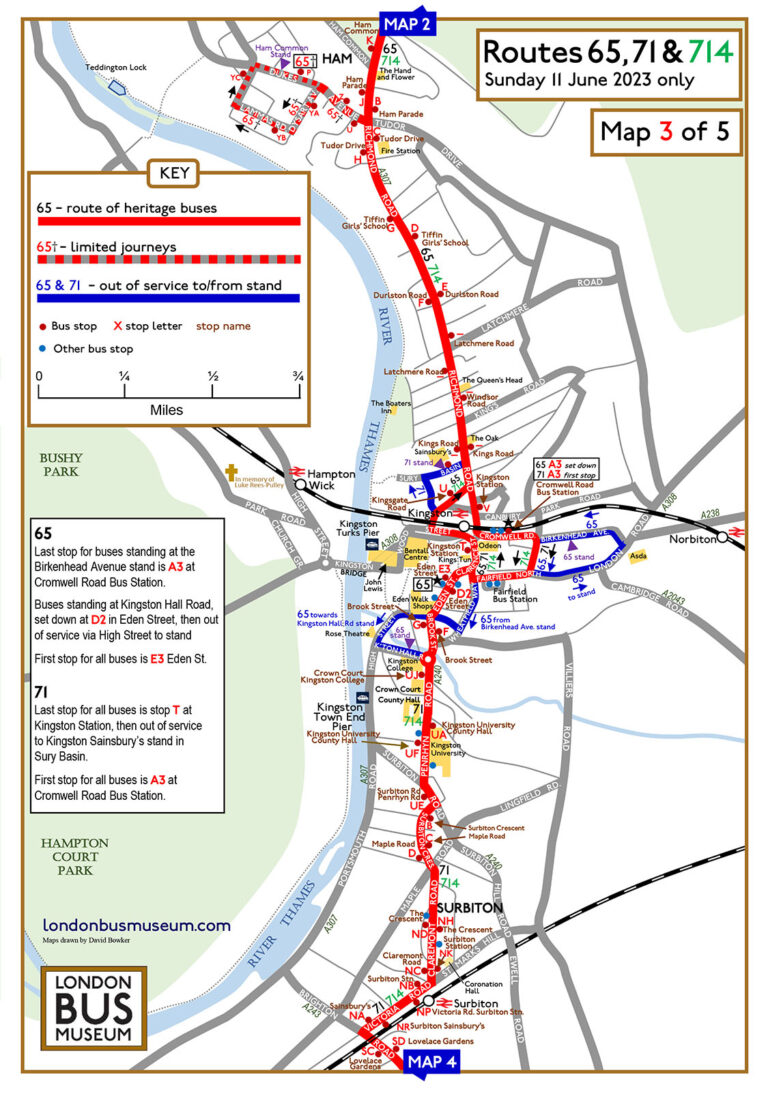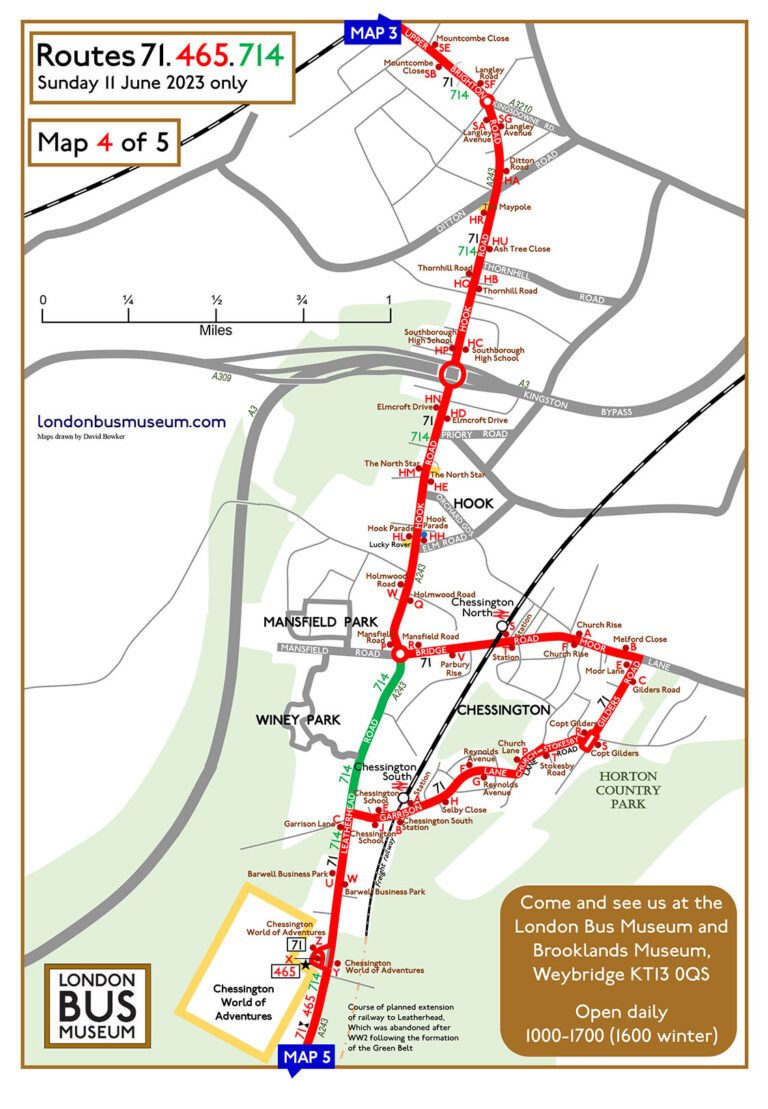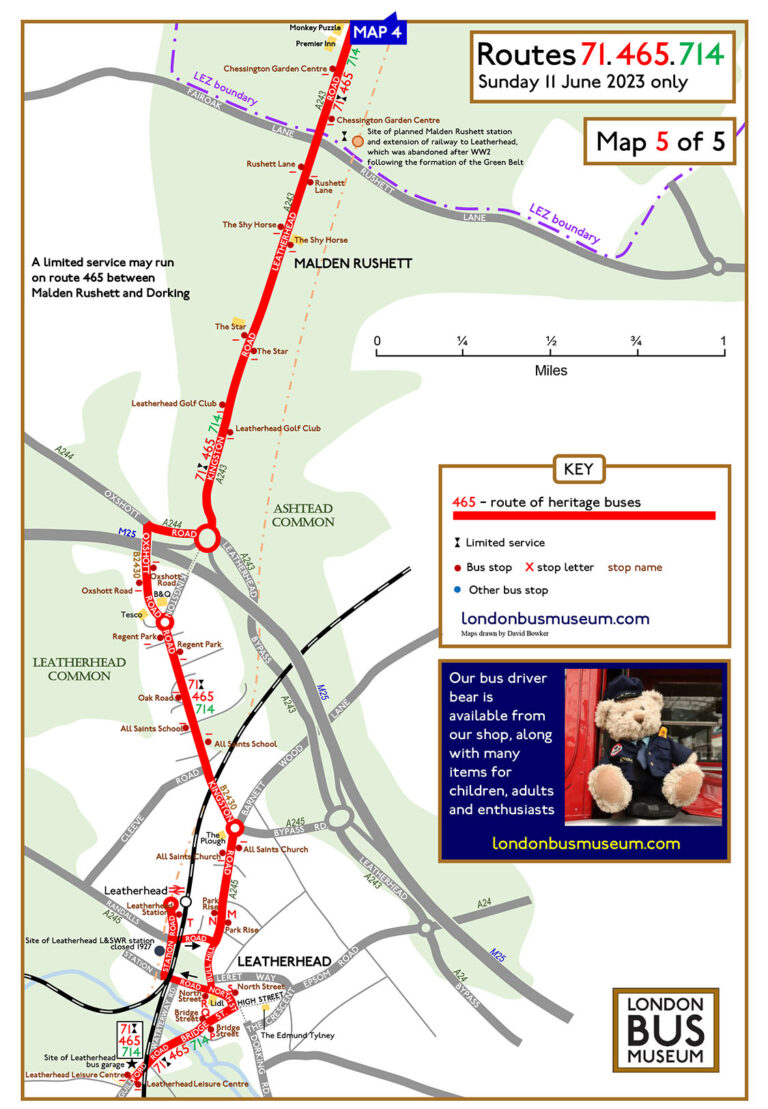Routes 65 and 71 Heritage Event ~ Ealing - Kingston - Leatherhead ~ Sunday 11th June 2023
Page updated 1st August 2023 ~ event video
As part of the London Bus Museum's programme of bringing heritage buses to the roads of London, this event sees heritage buses dating from the 1940s to 1970s running alongside the normal daily service on route 65, Ealing to Kingston and on route 71 between Kingston and Chessington. A feeder service 71 will run from East Acton to Kingston, morning and return.
- Event flyer [PDF]
- Route 65 timetable v4 [PDF]
- Route 71 timetable v4 [PDF]
- Route 71 feeder timetable East Acton <> Kingston v2 [PDF]
- Route 65 and 71 bus list v3 [PDF]
- Maps of the services are here.
- Route 65 history
- Route 65 and 71 photographs taken through the years

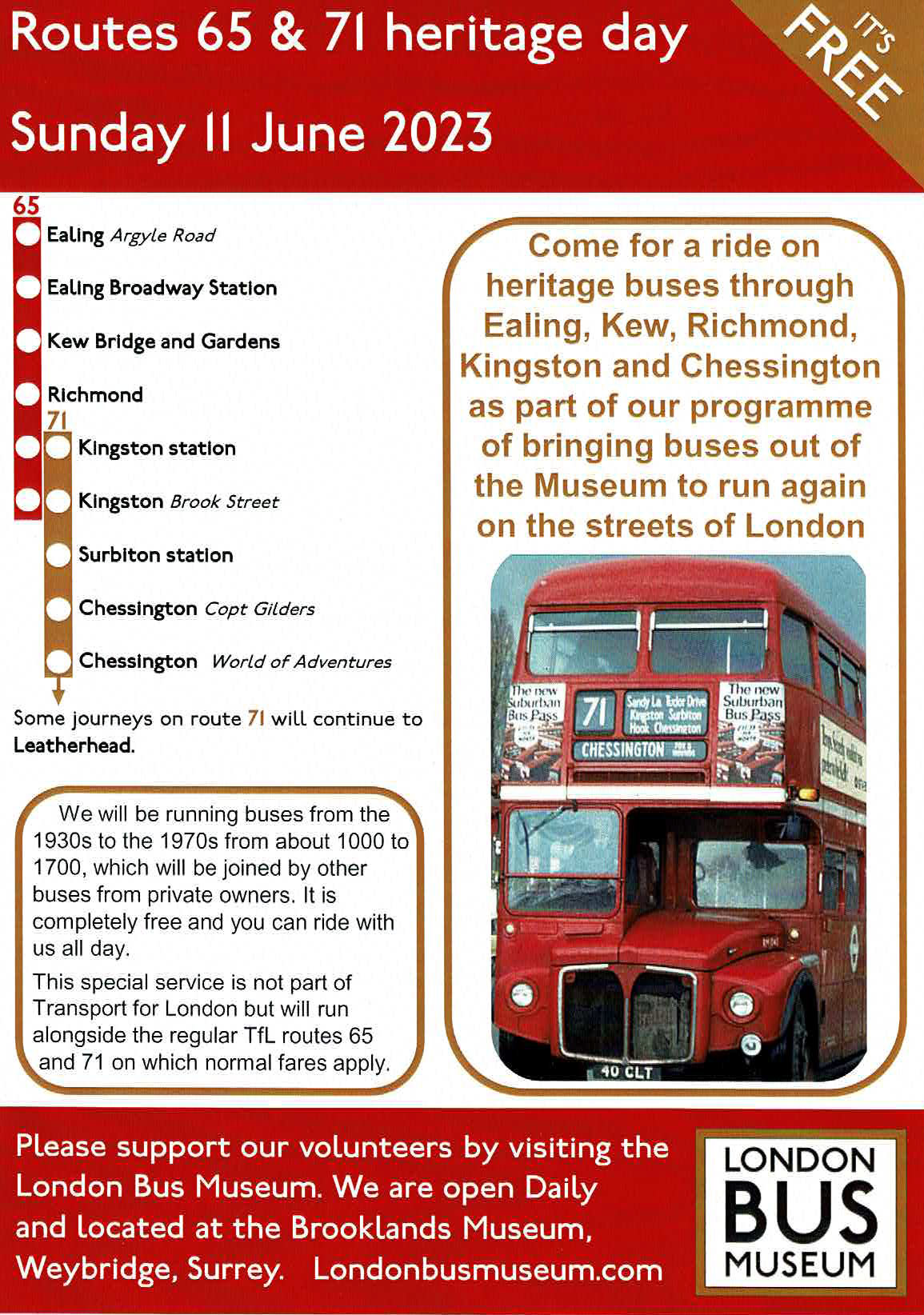
Photo: Not scheduled to occur on 11th June 2023!
Undated (but between 1968 and 1975) newspaper report of a route 65 mishap at Copt Gilders.
Route 65 Photo Gallery
- Hover for caption
![RATP London United Scania Omnicity SP40102 in heritage livery - Eden Street, Kingston - 29 July 2021 [David Harman] RATP London United Scania Omnicity SP40102 in heritage livery - Eden Street, Kingston - 29 July 2021 [David Harman]](https://www.londonbusmuseum.com/wp-content/uploads/cache/2022/11/xRte65Scania/3676611232.jpg)
![RATP London United Volvo B5LH / Wright Gemini 3 45162 - Castlebar Road, Ealing - 22 May 2021 [David Harman] RATP London United Volvo B5LH / Wright Gemini 3 45162 - Castlebar Road, Ealing - 22 May 2021 [David Harman]](https://www.londonbusmuseum.com/wp-content/uploads/cache/2022/11/xRte65Volvo/2988122398.jpg)
Route 71 Photo Gallery
- Hover for caption
Route 65 history
In 1911, the London Central Omnibus Co. was operating motor buses in the Kingston area and extended one of their routes to Richmond daily and on to Kew Bridge on Sundays. Their operations were taken over by the London General Omnibus Co (LGOC) in 1913, who numbered the route 71. Within weeks, the 71 was extended to run between Surbiton and Ealing Broadway via Twickenham, with the present route via Ham and Petersham commencing in May 1913. The route was renumbered 105 in March 1914, running daily from Ealing Argyle Road until the 1924 renumbering.
The LGOC introduced extended route 105A between Ealing and Leatherhead in May 1914, initially on Sundays only to cater for leisure traffic. After a break in the last years of the first world war, it was reintroduced to run daily as far as Hook and to Leatherhead on summer weekends. It became daily to Leatherhead from November 1921.
A new numbering scheme for London buses was adopted in December 1924, the 105 and 105A becoming route 65. Apart from some minor adjustments, the route continued unchanged until 1966, still with some journeys running only as far south as Kingston, Hook or Chessington Zoo (which opened in 1931). On the last day of 1966, the route was replaced at weekends by route 65A, formerly 265, which operated via Copt Gilders in Chessington and was extended to Leatherhead at weekends.
In November 1968, the 65 was withdrawn south of Chessington Zoo and rerouted via Copt Gilders, leaving the ‘main road’ route to Leatherhead to an extended 71. The 71 had been reintroduced between Kingston and Richmond in 1950, now operating the indirect route via Ham Estate and Tudor Drive (separated in 1990 to become the 371). The 71 was itself replaced temporarily by new route 265 in 1979-80, and when reintroduced ran via Copt Gilders and only to Chessington Zoo. The Surrey section was then served only by Green Line route 714, until the introduction of route 465 (Kingston to Dorking and, until 1997, Horsham) in June 1991.
Throughout this period, routes 65 and 71 had served the Hawker (later British Aerospace) factory in Ham, where the Harrier jump-jet and Hawk (as used by the Red Arrows) were built; special journeys were provided to fit with factory shift times. The factory closed in 1992.
Between 1968 and 1982, the Argyle Road to Ealing Broadway section was reduced to peak hours only, and was covered entirely by other routes from September 1982. Then in February 1987 (June 1987 on Sundays), the Kingston to Chessington Zoo section was withdrawn, passengers for the Zoo travelling by 71 via Copt Gilders.
Since then the service has essentially been as it is now, with the 65 running from Ealing Broadway to Kingston and the 71 running from Kingston to Chessington Zoo, both as frequent services. The 71 is supplemented every 30 minutes (hourly on Sundays) by the 465 to Dorking.
Buses operated
Initially operated by solid-tyred B-types, the 1920s saw a mix of S-types and the newer NSs, operated variously from E (Acton), AB (Twickenham) and Turnham Green (V) garages, then Kingston (K) when it opened in January 1922. From 1930 the route was shared between V and K. New STs were introduced in 1931, and these worked on the route until largely usurped by diesel STLs during the war, when petrol vehicle use dropped substantially. In 1948/9, these types were progressively replaced by RTs and (for a couple of years) RTLs from V. The new Norbiton garage (NB) took over from K when it opened in 1952, sharing the route with V until K replaced V in stages during 1968-71. The RTs ran until 1975, then Routemasters until OMO conversion in 1986, with a brief period of Sunday RML operation from Hanwell (HL) in 1985.
OMO conversion commenced from NB with M-class Metrobuses, alongside some DMS Fleetlines, until the route was tended by London Buses and the contract won by Armchair Passenger Transport in 1990. However, Armchair’s new Olympians took some time to arrive, and London & Country operated the route for 4 months in the interim. After 12 years’ operation by Armchair, the contract was won by London United (now part of RATP), who have operated it ever since. The initial TA-class Tridents were replaced by Polish-built SP-class Scanias, later, VH-class Wright Eclipse Gemini 3-bodied Volvos, and now BCE-class BYD / ADL Enviro400 EV City electrics.
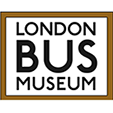
![Hook looks rather different these days. Ex-LGOC STL179 runs to Ealing Argyle Road in 1949, having just crossed the A3 and chased by a 10T10 on Green Line route 714. [Alan B Cross] STL179](https://www.londonbusmuseum.com/wp-content/uploads/cache/2021/03/65_STL179_0849_ABC2/1163808071.jpg)
![Carrying a 1938 ‘STL12’ body, low-numbered STL59 received its replacement body in 1946. [Alan B Cross] STL59](https://www.londonbusmuseum.com/wp-content/uploads/cache/2021/03/65_STL59_0849_ABC3/3000156415.jpg)
![RT operation officially spanned the period 1948 to 1975, although RTs continued to substitute occasionally for Routemasters for another few years. RT1538 crosses Kew Bridge in 1975. [Graham Burnell] RT1538](https://www.londonbusmuseum.com/wp-content/uploads/cache/2021/03/65_RT1538_KewBridge_1975_GrahamBurnell-scaled/1786642122.jpg)
![RT4286 [David Bowker] RT4286 [David Bowker]](https://www.londonbusmuseum.com/wp-content/uploads/cache/2022/12/x65-RTA096B/4213380176.jpg)
![On the last day of scheduled RT operation, RT4165 and RM427 share the traditional 65 stand at Ealing Broadway. [Fred Ivey]](https://www.londonbusmuseum.com/wp-content/uploads/cache/2021/03/65_EalingBdy_FredIvey-75_570_181075lastdayscheduledRT-scaled/2980668948.jpg)
![RM797 [David Bowker] RM797 [David Bowker]](https://www.londonbusmuseum.com/wp-content/uploads/cache/2022/12/x65-RMB169B/1552855156.jpg)
![RML2630 [David Bowker] RML2630 [David Bowker]](https://www.londonbusmuseum.com/wp-content/uploads/cache/2022/12/x65-RMB214A/1581180165.jpg)
![Bellbottoms and RM1975 at the Dysart Arms, Petersham [David Bowker] Bellbottoms and RM1975 at the Dysart Arms, Petersham [David Bowker]](https://www.londonbusmuseum.com/wp-content/uploads/cache/2022/12/x65-RMA257A/207624388.jpg)
![Shillibeer-livereid RM2130 [David Bowker] Shillibeer-livereid RM2130 [David Bowker]](https://www.londonbusmuseum.com/wp-content/uploads/cache/2022/12/x65-RMA213A/1579753743.jpg)
![A scene at Chessington Zoo, soon after bus deregulation outside London in 1986. The Epsom Coaches coach is operating route 568, the subsidised replacement for the 468, and sits between LT Metrobuses working routes 65 and 71, both of which will serve Kingston. [John Norman]](https://www.londonbusmuseum.com/wp-content/uploads/cache/2021/03/568-Epsom-Coaches-65-71-John-Norman/2542417313.jpg)
![Metrobus M1268 [David Bowker] Metrobus M1268 [David Bowker]](https://www.londonbusmuseum.com/wp-content/uploads/cache/2022/12/x65-LTB327A/656219662.jpg)
![London & Country AN223 [David Bowker] London & Country AN223 [David Bowker]](https://www.londonbusmuseum.com/wp-content/uploads/cache/2022/12/x65-LTC395A/2172063114.jpg)
![During London & Country’s temporary operation of the 65 in 1990, Leatherhead garage’s Atlantean AN226 runs north from Kingston to an unknown destination. [Graham Burnell]](https://www.londonbusmuseum.com/wp-content/uploads/2021/03/65_AN226_Kingston_1991_GB-2-2.jpg)
![In the early years of route tendering, operators were permitted to use their own livery. Here Armchair’s Olympian H553GKX stops in Eden Street, Kingston. [Steve Guess] Armchair H533 GKX](https://www.londonbusmuseum.com/wp-content/uploads/cache/2021/03/Armchair-Olympian-H553GKX-Kingston-Steve-Guess/3547937749.jpg)
![Armchair Passenger Transport Leyland Olympian H561 GKX [David Bowker] Armchair Passenger Transport Leyland Olympian H561 GKX [David Bowker]](https://www.londonbusmuseum.com/wp-content/uploads/cache/2022/12/x65-LTD246A/4267459597.jpg)
![RATP Dev Transit London BYD D8UR/ADL E400EV City BCE47054 (LG71 DWO) - Richmond, Quadrant - 3 Sep 2022 [David Harman] RATP Dev Transit London BYD D8UR/ADL E400EV City BCE47054 (LG71 DWO) - Richmond, Quadrant - 3 Sep 2022 [David Harman]](https://www.londonbusmuseum.com/wp-content/uploads/cache/2022/10/BYD-rte65/306568294.jpg)
![RATP Transit London BYD D8UR - DD / ADL E400EV City BCE47070 (ER70 LXX) in Queen Elizabeth II Platinum Jubilee livery ~ Richmond, Railway Station ~ 3rd September 2022 [David Harman] RATP Transit London BYD D8UR - DD / ADL E400EV City BCE47070 (ER70 LXX) in Queen Elizabeth II Platinum Jubilee livery ~ Richmond, Railway Station ~ 3rd September 2022 [David Harman]](https://www.londonbusmuseum.com/wp-content/uploads/cache/2023/04/Rte65-QEII/3097868307.jpg)
![RT4286 [David Bowker] RT4286 [David Bowker]](https://www.londonbusmuseum.com/wp-content/uploads/cache/2022/12/x65-RTA096B/714646306.jpg)
![RT4286 [David Bowker] RT4286 [David Bowker]](https://www.londonbusmuseum.com/wp-content/uploads/cache/2022/12/x71-RTA095B/2977661694.jpg)
![RT1107 [David Bowker] RT1107 [David Bowker]](https://www.londonbusmuseum.com/wp-content/uploads/cache/2022/12/x71-RTA095A/510311366.jpg)
![RM729 [David Bowker] RM729 [David Bowker]](https://www.londonbusmuseum.com/wp-content/uploads/cache/2022/12/x71-RMB221A/2705858179.jpg)
![RM1579 [David Bowker] RM1579 [David Bowker]](https://www.londonbusmuseum.com/wp-content/uploads/cache/2022/12/x71-RMA238A/2674149585.jpg)
![RM1040 [David Bowker] RM1040 [David Bowker]](https://www.londonbusmuseum.com/wp-content/uploads/cache/2022/12/x71-RMA210A/638054985.jpg)
![RM1384 [David Bowker] RM1384 [David Bowker]](https://www.londonbusmuseum.com/wp-content/uploads/cache/2022/12/x71-RMA209A/1989039135.jpg)
![RM1748 [David Bowker] RM1748 [David Bowker]](https://www.londonbusmuseum.com/wp-content/uploads/cache/2022/12/x71-RMA206B/569791632.jpg)
![RF314 outside Leatherhead Garage [David Bowker] RF314 outside Leatherhead Garage [David Bowker]](https://www.londonbusmuseum.com/wp-content/uploads/cache/2022/12/x71-LTA299A/519300044.jpg)
![Metrobus M1262 [David Bowker] Metrobus M1262 [David Bowker]](https://www.londonbusmuseum.com/wp-content/uploads/cache/2022/12/x71-LTC096A/1934869502.jpg)
![Fleetline DMS714 in Kingston Bus livery [David Bowker] Fleetline DMS714 in Kingston Bus livery [David Bowker]](https://www.londonbusmuseum.com/wp-content/uploads/cache/2022/12/x71-LTC248A/4258965127.jpg)
![RATP London United Scania Omnicity SP40074 - Penrhyn Road, Kingston - 29 Jul 2021 [David Harman] RATP London United Scania Omnicity SP40074 - Penrhyn Road, Kingston - 29 Jul 2021 [David Harman]](https://www.londonbusmuseum.com/wp-content/uploads/cache/2022/12/RATP-LU-Scania-SP40074/3181830249.jpg)
![RATP London United Volvo BL5H / Wright Gemini 3 VH45175 - Claremont Road, Surbiton - 13 Aug 2021 [David Harman] RATP London United Volvo BL5H / Wright Gemini 3 VH45175 - Claremont Road, Surbiton - 13 Aug 2021 [David Harman]](https://www.londonbusmuseum.com/wp-content/uploads/cache/2022/12/RATP-LU-Volvo-VH45175/45328172.jpg)
